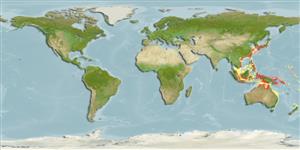>
Ovalentaria/misc (Various families in series Ovalentaria) >
Pomacentridae (Damselfishes) > Chrominae
Etymology: Chromis: Greek, chromis = a fish, perhaps a perch (Ref. 45335); albicauda: Name from Latin meaning 'white tail' for its diagnostic feature that separates this species from Chromis analis.
Environment: milieu / climate zone / depth range / distribution range
Οικολογία
Θαλασσινό(ά) Υφαλόφιλο(α); εύρος βάθους 25 - 70 m (Ref. 90102), usually ? - 30 m (Ref. 82433). Tropical
Western Pacific: Indonesia and southern Japanese seas; distribution probably disjunct due to association with cool temperature regimes.
Μέγεθος / Βάρος / Age
Maturity: Lm ? range ? - ? cm
Max length : 13.4 cm SL αρσενικό/απροσδιόριστο; (Ref. 82433)
Short description
Κλείδες προσδιορισμού | Μορφολογία | Μορφομετρία
Ραχιαίες άκανθες (συνολικά) : 13; Μαλακές ραχιαίες ακτίνες (συνολικά) : 11 - 12; Εδρικές άκανθες: 2; Μαλακές εδρικές ακτίνες: 11 - 12. This species is distinguished by the following characters: D XIII,12 (rarely 11); A II,12 (rarely 11); pectoral rays 18-20; spiniform caudal rays 3; tubed lateral-line scales 17-19; gill rakers 7-8 + 24-26, total rakers 24-26; body depth 1.8-1.9 in SL; edge of suborbital hidden by scales; 4-5 scale rows on anterior portion of preorbital; generally yellow in life, grading to brown on upper back with abruptly white caudal fin; blackish anal opening which is also evident in preserved specimens (Ref. 82433).
Adults are commonly observed in areas of cool (18°-24°C) upwelling along the northern and western shores of Nusa Penida at about 25-50 m. They typically form aggregations, which feed high in the water column on zooplankton when currents are strong (Ref. 82433). Oviparous, distinct pairing during breeding (Ref. 205). Eggs are demersal and adhere to the substrate (Ref. 205). Males guard and aerate the eggs (Ref. 205).
Life cycle and mating behavior
Γεννητική Ωρίμανση | Αναπαραγωγή | Γεννοβολία | Αβγά | Γονιμότητα | Προνύμφες
Oviparous, distinct pairing during breeding (Ref. 205). Eggs are demersal and adhere to the substrate (Ref. 205). Males guard and aerate the eggs (Ref. 205).
Allen, G.R. and M.V. Erdmann, 2009. Two new species of damselfishes (Pomacentridae: Chromis) from Indonesia. aqua, Int. J. Ichthyol. 15(3):121-134. (Ref. 82433)
IUCN Red List Status (Ref. 130435: Version 2024-1)
Threat to humans
Harmless
Human uses
αλιεία: παραδοσιακή αλιεία
Εργαλεία
Special reports
Download XML
Διαδικτυακές πηγές
Estimates based on models
Phylogenetic diversity index (Ref.
82804): PD
50 = 0.5000 [Uniqueness, from 0.5 = low to 2.0 = high].
Bayesian length-weight: a=0.01820 (0.00804 - 0.04119), b=2.99 (2.81 - 3.17), in cm total length, based on LWR estimates for this Genus-body shape (Ref.
93245).
Τροφικό Επίπεδο (Ref.
69278): 3.0 ±0.1 se; based on size and trophs of closest relatives
Ελαστικότητα (Ref.
120179): Μεσαίο(α), ελάχιστος χρόνος για διπλασιασμό πληθυσμού 1,4 - 4,4 έτη (Preliminary K or Fecundity.).
Fishing Vulnerability (Ref.
59153): Low vulnerability (10 of 100).
